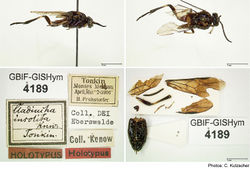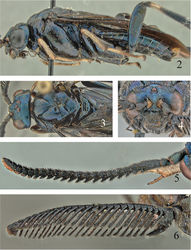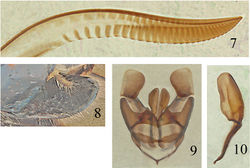Cladiucha insolita
| Notice: | This page is derived from the original publication listed below, whose author(s) should always be credited. Further contributors may edit and improve the content of this page and, consequently, need to be credited as well (see page history). Any assessment of factual correctness requires a careful review of the original article as well as of subsequent contributions.
If you are uncertain whether your planned contribution is correct or not, we suggest that you use the associated discussion page instead of editing the page directly. This page should be cited as follows (rationale):
Citation formats to copy and paste
BibTeX: @article{Smith2017JournalofHymenopteraResearch, RIS/ Endnote: TY - JOUR Wikipedia/ Citizendium: <ref name="Smith2017Journal of Hymenoptera Research">{{Citation See also the citation download page at the journal. |
Ordo: Hymenoptera
Familia: Tenthredinidae
Genus: Cladiucha
Name
Cladiucha insolita Konow – Wikispecies link – Pensoft Profile
Description
Female: Length 15–17 mm (holotype, 17 mm). Black, with light purple metallic lustre, with following white: labrum brown to white; apical 3 or 4 antennomeres ventrally; narrow stripe on upper surface of hind coxa; outer surface of apical half of fore femur; inner surfaces of basal two-thirds of mid and hind femora; fore and mid tibiae except for black apex; basal third of hind tibia; fore and midtarsi; small lateral spot on first tergite; small transverse stripe at center of apical tergite; apical margin of apical tergite; cercus brown to white. Wings darkly uniformly infuscated; veins and stigma black. Head: With short, white hairs; rugose to punctate on frons, interantennal area, and clypeus, shiny with scattered punctures on vertex and gena. Antenna (Fig. 5) with 21–23 antennomeres (holotype 23), first and second about as long as broad, third about 2 × longer than broad, fourth to 19th or 20th antennomeres with apex broader than long and with short apically projecting rami; length of rami about equal to basal width of antennomere; apical 3 antennomeres without rami; apical 5 or 6 antennomeres with pale ventral sensory areas; length 1.8 × head width. Malar space very short, less than half diameter of front ocellus; lower interocular distance 1.3 × eye height; distances between eye and hind ocellus, between hind ocelli, and between hind ocellus and posterior margin of head as 1.0:0.8:1.3; postocellar area slightly convex, about 1.2 × broader than long. Thorax: Shiny with short, white hairs; almost impunctate, with very few small widely-spaced punctures on mesonotum and somewhat larger punctures on posterior half of mesoscutellum and posttergite. Forewing with vein 2A+3A basal to the anal cross vein complete, faint, or partially atrophied (partially atrophied in holotype). Hindwing without cell M, but partially present or present in about half of specimens examined (absent in holotype); anal cell with short petiole. Tarsal claw with long inner tooth, longer and stouter than outer tooth. Hind basitarsus about 5.0 × longer than broad. Pulvilli on hind tarsomeres 1–4, those on 3 and 4 larger than those on 1 and 2. Abdomen: Shiny. Sheath (Fig. 8) uniformly slender in dorsal view; straight above and rounded at apex and below in lateral view. Cercus about 3.0 × longer than broad, half length of sawsheath. Lancet (Fig. 7) with about 30 serrulae; serrulae flat with 4 or 5 anterior subbasal teeth, serrulae indistinct at apex. Male: Length 10–13 mm. Color as female except hind coxa entirely black; abdomen black; harpe whitish on apical third to half. Similar to female except for antenna and sexual characters. Head: Antenna (Fig. 6) with 27–29 antennomeres, bipectinate except apical antennomere; apical antennomere rounded, blunt at apex; rami long, those of central rami equal to length of 6 or 7 antennomeres; third antennomere with inner ramus about half length of outer ramus; length 1.5 × head width. Abdomen: Hypandrium rounded at apex. Genitalia in Figs 9, 10; harpe slightly expanded toward apex, apex broadly rounded; penis valve sharply bent, valviceps oval.
Specimens examined
LAOS: NE Laos, Hua Phan Pr., Mt. Phu Pane, ~1500 m, 20°12'N, 103°59'E, S-Jak1, 1-20.VI.2011 (3 ♀), same except 10-22.V.2011 (2 ♀); Prov. Hua Phan, Phou Pan, Umg. Ort Ban Saleui, 20°13'30"N, 103°59'26"E, 1350-1900 m MSL, 11.V.2011, leg. C. Holzschuh & locals (2 ♀), same except 21.V.2011 (1 ♀), 16.V.2011 (2 ♂), 18.IV.2012 (1 ♀, 1 ♂), 23.IV.2012 (1 ♀); Hua Phan Prov., Ban Salleui; Phou Pan. Mt., 20°13'30"N, 103°59'26"E, 1350-1900 m, 16.V.2011, leg. C. Holzschuh + locals (2 ♂), same except 18.IV.2010 (1 ♀, 1) , 19.IV.2010 (1 ♂), 01.V.2010 (2 ♀, 1 ♂), 13.V.2010 (1 ♂), 08.V.2011 (3 ♀, 1 ♂), 21.V.2011 (1 ♀, 2 ♂), 13.V.2011 (1 ♀, 1 ♂), 07.V.2011 (1 ♀), 15.V.2011 (2 ♂), 19.V.2011 (1 ♂), 24.IV.2010 (1 ♂), 01.V.2011 (1 ♀), 05.V.2011 (1 ♂), 06.V.2011 (1 ♀), 29.IV.2012 (1 ♀). VIETNAM: Holotype female: “Tonkin (Mauson-Gebirge)” (Konow 1902[3]), „Tonkin, Montes Mauson“ on label (Fig. 1).
Distributon
Laos, Vietnam.
Variation
The length of specimens of each sex varies by 2 or 3 mm, the female from 15–17 mm and the male from 10–13 mm. The number of antennomeres in the female varies from 21–23 and in the male 27–29. In the forewing, the portion of vein 2A+3A basal to the anal crossvein is partially atrophied in most specimens (17), but faint to present in several (4). In the hind wing in specimens where visible, cell M is absent in most specimens (14), but present or partially present in others (11), or present in one wing and absent in the other (3).
Discussion
The holotype was collected in „April, Mai“, consistent with the April and May collection dates of specimens examined.
In existing keys to species of Cladiucha (Xiao 1994[1], Wei 2010[2]), the black color, absence of cell M in the hind wing, length of the female, and number of antennomeres were used to separate C. insolita. Both sexes of C. insolita will key correctly, though use of these characters needs some discretion because of the variation noted. The black clypeus and pronotum seem to be the most stable characters to use.
Comparison with the figures in Xiao, the male appears closest to C. manglietiae (Xiao 1994[1], fig. 11). Both have the penis valve of similar shape and strongly curved. In C. magnoliae, the penis valve is straight (Wei 2010[2], fig. 15) and the harpe more oval and broadly rounded apically (Wei 2010[2], fig. 13) than the longer and more parallel-sided harpe of C. insolita (Fig. 9).
The serrate serrulae of the female with about 6 subbasal teeth, is more similar to C. magnoliae (Wei 1997[4], fig. 15; Wei 2010[2], fig. 12) than the more widely separated serrulae with only about three subbasal teeth of C. manglietiae (Xiao 1994[1], fig. 7).
Wei (1997)[4] described a new subgenus, Acladiucha, for C. magnoliae, separated from the typical subgenus by the closed cell M in the hindwing, presence of 19 or 20 antennomeres in the female and 23 in the male, linear malar space, and serrulae of the lancet widely separated. Taeger et al. (2010)[5] did not recognize subgenera and synonymized Acladiucha under Cladiucha. Considering the variation noted in C. insolita and only the slightly broader malar space and shape of the serrulae, recognition of subgenera does not seem warranted.
Taxon Treatment
- Smith, D; 2017: Rediscovery of Cladiucha insolita Konow (Hymenoptera, Tenthredinidae), description of the male and intraspecific variation Journal of Hymenoptera Research, (60): 173-179. doi
Images
|
Other References
- ↑ 1.0 1.1 1.2 1.3 Xiao G (1994) Redescription of the genus Cladiucha (Hymenoptera: Tenthredinidae) and descriptions of two new species from China. Journal of Beijing Forestry University (English Ed. ) 3: 15–22.
- ↑ 2.0 2.1 2.2 2.3 2.4 Wei M (2010) A new species of Cladiucha Konow (Hymenoptera, Tenthredinidae) from China with a key to sawfly species damaging plants of Magnoliaceae. Acta Zootaxonomica Sinica 35: 635–640. [In Chinese, English summary]
- ↑ Konow F (1902) Neue Blattwespen. (Hym.). Zeitschrift für systematische Hymenopterologie und Dipterologie 2: 384–390.
- ↑ 4.0 4.1 Wei M (1997) A new subfamily and two new genera of Tenthredinidae (Hymenoptera: Tenthredinomorpha). Entomotaxonomia 19, Suppl.: 76–. $6
- ↑ Taeger A, Blank S, Liston A (2010) World catalog of Symphyta (Hymenoptera). Zootaxa 2580: 1–1064.


